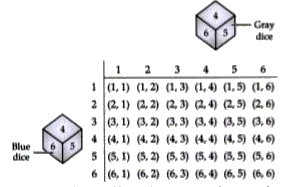Two dice, one blue and one grey, are thrown at the same time. Write down all the possible outcomes. What is the probability that the sum of the two numbers appearing on the top of the dice is
(i)8 ,
(ii) 13?
(ii) less than or equal to 12?
if two dices are thrown, the total possible outcomes will be:
(1,1) , (2,1) , (3,1) , (4,1) , (5,1) , (6,1)
(1,2) , (2,2) , (3,2) , (4,2) , (5,2) , (6,2)
(1,3) , (2,3) , (3,3) , (4,3) , (5,3) , (6,3)
(1,4) , (2,4) , (3,4) , (4,4) , (5,4) , (6,4)
(1,5) , (2,5) , (3, 5) , (4,5) , (5,5) , (6,5)
(1,6) , (2,6) , (3,6) , (4,6) , (5,6) , (6,6)
now, total possible outcomes are 36
(i) outcomes = (2+6) , (3+5), (4+4) , (5+3), (6+2)
P(SUM=8) = 536
(ii) outcomes= 0
P(SUM=13) = 036=0
(iii) outcomes= (1+1) , (1+2), (1+3), (1+4), (1+5), (1+6), (2+1), (2+2), (2+3), (2+4), (2+5), (2+6), (3+1), (3+2), (3+3), (3+4), (3+5), (3+6), (4+1),(4+2),(4+3),(4+4) , (4+5), (4+6), (5+1) , (5+2), (5+3), (5+4), (5+5), (5+6), (6+1), (6+2),(6+3),(6+4),(6+5),(6+6)
P(SUM<=12) = 3636=1
Similar Questions
Two dice, one blue and one grey, are thrown at the same time. Write down all the possible outcomes. What is the probability that the sum of the two numbers appearing on the top of the dice is
(i)8 ,
(ii) 13?
(ii) less than or equal to 12?
View SolutionTwo dice are thrown at the same time. Write down the possible outcomes. Find the probability of getting the sum of two numbers appearing on the top of the dice as :
(i) 13 (ii) less than 13 (iii) 10 (iv) less than 10.
View Solution
Knowledge Check
Two dices are thrown simultaneously. What is the probability that the sum of the numbers appearing on them is a prime number?
A5/12B1/2C7/12D2/3

Two dice, one blue and one grey are thrown at the same time.
What is the probability that the sum of the two numbers appearing on the top of the dice is 8 ?
View SolutionA black die and a white die are thrown at the same time. Write all the possible outcomes. What is the probability? that the sum of the numbers appearing on the top of the dice is less than or equal to 12? that the product of numbers appearing on the top of the dice is less than 9. (iii) that the difference of the numbers appearing on the top of the two dice is 2.
View Solution
Two dice, one blue and one grey are thrown at the same time.
How many total number of favourable outcomes are here?
View Solution
Two dice, one blue and one grey are thrown at the same time.
Find the Probability that the sum of the two numbers appearing on the top to the dice is 11.
View SolutionTwo dice are thrown simultaneously. What is the probability that the sum of the number appearing on the dice is
(i) 7? (ii) a prime number? (iii) 1?
View Solution
Two dice, one blue and one grey are thrown at the same time.
Find the probability of getting an even number as the sum.
View SolutionTwo dice are thrown. What is the probability that the sum of the numbers appearing on the two dice is 11, it 5 appears on the first?
View Solution
